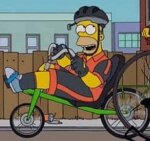Beg Light Article
Our Community › Forums › General Discussion › Beg Light Article
- This topic has 14 replies, 12 voices, and was last updated 9 years, 4 months ago by
mstone.
-
CreatorTopic
-
March 3, 2016 at 3:08 pm #917952
S. Arlington Observer
ParticipantThis is mostly about pedestrians, but I think the logic applies to cycling as well. It is going to be a long haul to get across the idea that roads are for everyone, not just motorists and cars. (And, like most of us, I am sometimes as motorist or pedestrian.)
Why Do Pedestrians Have to Press ““Beg Buttons” to Cross the Street?
-
CreatorTopic
-
AuthorReplies
-
March 3, 2016 at 4:07 pm #1048787
consularrider
ParticipantAt least the “beg” light button is usually somewhere the pedestrian can reach it without a lot of extra effort. Not so for a cyclist. I don’t have an issue with the “beg” light for pedestrians when the light for the more minor street is on a sensor loop, but also wonder why a pedestrian would have to push a button for a walk light in any other circumstance (yeah, ok, sometimes that gives the light a longer cycle, but my experience has been that that is rare on timed lights).
March 3, 2016 at 4:11 pm #1048790 jrenautParticipant
jrenautParticipantThe proper way to handle a beg button is to press the button then jaywalk/ride as soon as it’s clear. Best case scenario is you’re long gone before traffic stops. It probably needed calming anyway.
March 3, 2016 at 5:55 pm #1048801mstone
ParticipantThe beg button does serve one useful purpose: it signals whether your DOT is really a Department of Cars.
March 3, 2016 at 6:06 pm #1048802 lordofthemarkParticipant
lordofthemarkParticipantYou can either have timed lights, or lights that are responsive to the presence of cross traffic. Timed lights are not terribly efficient when almost all traffic is say, N-S at an E-W intersection. The N-S traffic will often be delayed for non-existent E-W traffic.
So many lights are set based on sensors. For motor vehicles. That works, until we add other users to the equation. There are now sensors that will sense bikes, and I understand they are being implemented at many locations in the region. The law in Virginia, as understand it, is if you wait two minutes, you (a cyclist) can assume no sensor has sensed you, and you may (carefully) proceed through the light.
For pedestrians, the beg button serves in place of a sensor. The article makes reference to pedestrian sensors. Not sure the cost, or if the advantages over the beg button justify it.
March 3, 2016 at 6:30 pm #1048803 jrenautParticipant
jrenautParticipant@lordofthemark 136085 wrote:
…if you wait two minutes, you (a cyclist) can assume no sensor has sensed you, and you may (carefully) proceed through the light…
Which is, in practice, completely absurd. Can you imagine if we made someone in a car wait two minutes for a light? No one would do it. And the buttons generally don’t change the timing of the cycle, right? They just make sure the next cycle includes the pedestrian walk signal. It would be different if hitting the button made the traffic light turn yellow immediately. Though that might invite abuse…
Beg buttons are like right on red – they only make sense in places that have just a few pedestrians or cyclists per day.
March 3, 2016 at 6:44 pm #1048805bobco85
ParticipantIIRC, there are some intersections that have pedestrian beg buttons that don’t use them all day. During times of high pedestrian traffic, the intersections will automatically display the walk signal, and during times of low pedestrian traffic, the intersections will default to requiring the beg button to trigger the walk signal.
Of course, the difficult part would be in programming the lights for peaks in pedestrian traffic along with making sure that traffic does not get unnecessarily slowed down (c’mon, we all know that car traffic efficiency tends to be prioritized over other modes of transportation).
March 3, 2016 at 7:07 pm #1048808 bentbike33Participant
bentbike33Participant@jrenaut 136073 wrote:
The proper way to handle a beg button is to press the button then jaywalk/ride as soon as it’s clear.
Especially the beg buttons that are not actually wired to anything.
March 3, 2016 at 7:11 pm #1048809TwoWheelsDC
Participant@jrenaut 136086 wrote:
Which is, in practice, completely absurd. Can you imagine if we made someone in a car wait two minutes for a light? No one would do it. And the buttons generally don’t change the timing of the cycle, right? They just make sure the next cycle includes the pedestrian walk signal. It would be different if hitting the button made the traffic light turn yellow immediately. Though that might invite abuse…
Beg buttons are like right on red – they only make sense in places that have just a few pedestrians or cyclists per day.
For the month of February I was given some extra duties that required being at work at 6am every day…so, I rode my motorcycle a lot, because I don’t have the motivation to cycle to work at 5am in the cold every day. Anyway, most of the lights on my commute have sensors, but also a bias toward the road I wasn’t on (so I was on the less busy of two roads and the lights would stay green for the busier road unless the sensor tripped). But at 530am, there are no cars to trip the sensors, so I found myself waiting at empty intersections with no hope of getting a green light. I calculated that if I waited the full two minutes at every light, that would add nearly 50% to my commuting time.
Let’s just say that I followed the spirit of the law, but found ways to not have those empty intersections take up as much time as they could have…
March 3, 2016 at 7:14 pm #1048812dplasters
Participant@jrenaut 136086 wrote:
Which is, in practice, completely absurd. Can you imagine if we made someone in a car wait two minutes for a light? No one would do it.
Out here in the sprawl I can think of many 3 minute length lights for cars (which I think is the VDOT maximum???). I grew up using the light at Huntsman Blvd and the Fairfax County Pkwy which is a 3 minute cycle. My current street, Circle Woods Dr and Lee Hwy is a 3 minute light as well. The 3 minute cycles starts at 6am on weekdays and I think 7 or 8am on weekends? and goes until 8 or 9pm? Then it reverts to more of a 1-2 minute cycle.
People do, as legally required, wait for the light to turn green.
The pedestrian areas near the Vienna metro all require beg buttons… then they wonder why people jaywalk.
March 3, 2016 at 7:34 pm #1048814dasgeh
ParticipantMy understanding is:
– Beg buttons are a relic of old technology. Newer technology allows for detection of all people, whether they are walking, biking or in cars. This technology is based on cameras, and is better than the loops anyway. However, right now the cameras are built/set to only detect whatever is in the road. In theory, the camera could capture an area including the sidewalk.
– If we could automatically detect all road users, we could get to a more efficient use of road space. However, even when we get there, there will be choices in prioritization, e.g. how long before a ped is detected before the cars get red.
– Right now, the system for letting the visually impaired be aware of traffic signals is embedded in the beg buttons, so even at places where the button isn’t used for detection, it’s used for its speaker system to let the visually impaired know when to cross.
– Arlington County sets all of its traffic lights either to always be auto-timed, or always use detection for one direction.
March 3, 2016 at 7:37 pm #1048815scoot
ParticipantThere are a lot of asymmetric intersections along suburban arterial highways with cycle times of 3 minutes.
@lordofthemark 136085 wrote:
The law in Virginia, as understand it, is if you wait two minutes, you (a cyclist) can assume no sensor has sensed you, and you may (carefully) proceed through the light.
It’s absurd to wait two minutes at each such intersection every day in order to confirm that a signal which couldn’t detect bikes yesterday still can’t detect them today. The law should be amended to allow Idaho behavior without a waiting period at any signal known to be defective in this way.
March 4, 2016 at 4:44 pm #1048874creadinger
Participant@jrenaut 136086 wrote:
Which is, in practice, completely absurd. Can you imagine if we made someone in a car wait two minutes for a light? No one would do it. And the buttons generally don’t change the timing of the cycle, right? They just make sure the next cycle includes the pedestrian walk signal. It would be different if hitting the button made the traffic light turn yellow immediately. Though that might invite abuse…
Beg buttons are like right on red – they only make sense in places that have just a few pedestrians or cyclists per day.
Not that it actually matters for your point or the point of this discussion, but I do know of several intersections around here where the green light W/walk signal cycle is significantly longer than the green light only.
I think in these cases engineers figured that the green cycle was WAY too short for slow moving pedestrians to actually cross 8 lanes of road in time, so when the beg button is pushed the walk cycle begins and the parallel green light signal is lengthened accordingly.
March 4, 2016 at 5:30 pm #1048876S. Arlington Observer
Participant@creadinger 136159 wrote:
I think in these cases engineers figured that the green cycle was WAY too short for slow moving pedestrians to actually cross 8 lanes of road in time, so when the beg button is pushed the walk cycle begins and the parallel green light signal is lengthened accordingly.
And this is precisely my beef with the buttons. If they help summon a signal change for pedestrians and/or cyclists they are useful. But there should be no difference in signal timing based on whether the button was pushed. Once the traffic signal does change, for whatever reason, (if there is a pedestrian crosswalk) the traffic signal should allow enough time for pedestrians and cyclists to cross. People have been taught to cross with the traffic signal, not necessarily the pedestrian walk signal that may or may not work. The mix of automatic and triggered pedestrian signals also confuses people.
I’ve seen plenty of people start into the intersection of Walter Reed Drive and Arlington Mill Drive when it truly was too late because they hesitated for a walk signal that did not come. If the signal was adjusted to always give time for pedestrians to cross and to always turn on the walk signal when the light changed, confusion would be eliminated and the effect on traffic on Walter Reed would be negligible. The varying light lengths (shorter if the button was not pushed in time) provide a very small gain for drivers at the expense of other users. Which, is unfortunately typical.
March 4, 2016 at 10:00 pm #1048887mstone
ParticipantOne of the major drivers for this is a mandate that crosswalk signals account for a specific (fairly slow) walking rate, which means that the signal to cross 8 lanes is really, really long. (You can get 30 cars in two turn lanes through an intersection faster than one person can cross the street under the formula.) In order to not have an empty intersection for a good percentage of the day the DOT eliminates the timed crosswalk signal and everything’s great (if you’re in a car). Alternative solution: road diet, so you don’t need to hold the crosswalk signal for the length of time it takes a slow pedestrian to cross 8 lanes. But that’s crazy talk, would require balancing the needs of all users, and flies in the face of VDOT’s hunger to widen everything in sight.
-
AuthorReplies
- You must be logged in to reply to this topic.